Maple syrup is a natural sweetener made by boiling and concentrating the sap of the maple tree, which results in a golden brown liquid with a distinctively sweet, earthy, and piney flavor.
Maple syrup is a popular alternative to table sugar, though it still contains a large amount of sugar itself and is best used in moderation.
If you are looking for the purest and healthiest maple syrup, we’ve ranked the ten best brands available right now. Read on for our rankings, plus more info on the benefits and side effects of maple syrup.
Research
Rankings
1. Runamok Maple Sugarmaker’s Cut Maple Syrup

Runamok Maple makes a maple syrup that’s exceptionally smooth and has an unparalleled depth of flavor. It’s great for classic dishes like pancakes and desserts, as well as making cocktails or adding sweetness to hot beverages.
The tree sap used to produce this maple syrup comes only from Vermont maple trees, and users love the versatility of this light-bodied but richly-flavored maple syrup. Thanks to its great flavor and wide variety of uses, this is our top pick.
2. Escuminac Maple Syrup
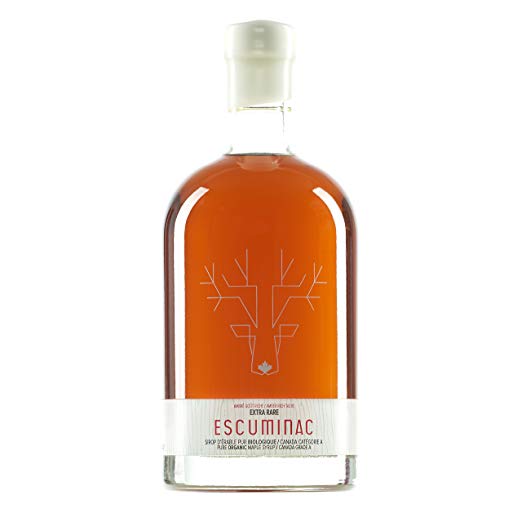
Escuminac Maple Syrup is an artisanal brand of maple syrup that’s produced in Canada and has an ultra-smooth flavor.
Its light and smooth flavor is not overwhelmed by sweetness, making it an extraordinarily well-balanced maple syrup.
The 17 ounce bottles are well-suited for occasional use, though people who go through a lot of maple syrup might want to opt for something that comes in a larger package.
3. Mead and Mead’s Maple Syrup
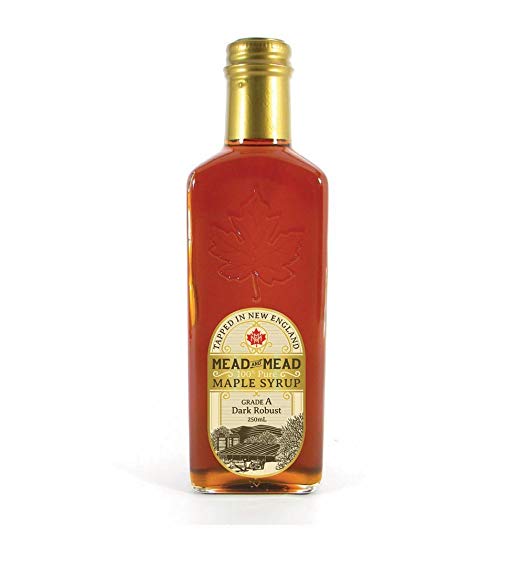
For those who are looking for a deep, richly-flavored maple syrup, Mead and Mead’s Maple Syrup is the best option. The buttery and earthy flavors put bland and mild maple syrups to shame.
It’s an excellent choice for those who appreciate the unique qualities that separate maple syrup from other liquid sweeteners.
4. Hidden Springs Maple Syrup

Hidden Springs Maple Syrup is an organically certified maple syrup that comes in a 32 ounce jug. It’s a deeper and darker flavor than most other maple syrup brands on the market, so if you are looking for something with strong flavor and earthy tones, this should definitely be your choice.
5. Canada’s Finest Maple Syrup

Canada’s Finest Maple Syrup makes a 17 ounce maple syrup that’s made from Canadian maple trees and is organically certified.
It’s a darker and more robustly flavored maple syrup, so while it might be a bit complex for people who prefer their sweeteners on the mild side, you’ll love this maple syrup if you appreciate a richer and earthy flavor.
6. Coombs Family Farms Maple Syrup

Coombs Family Farms Maple Syrup makes a very approachable and high quality maple syrup.
If not everyone in your family is ready for deep, robust maple syrup, but you want something that’s a step up from typical store-bought brands, definitely consider Coombs Family Farms Maple Syrup.
7. Butternut Mountain Farm Maple Syrup
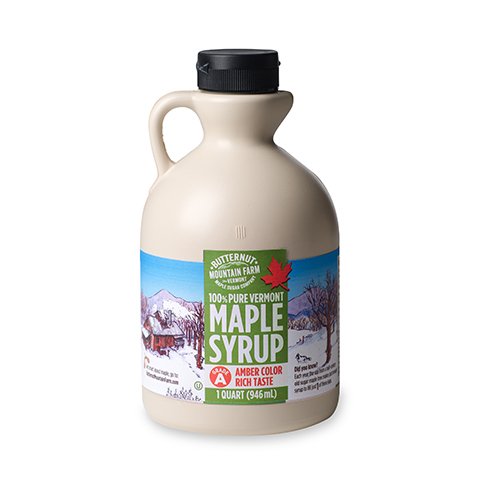
Butternut Mountain Farm Maple Syrup comes in a large 32 ounce jug and is produced entirely from maple trees in Vermont.
This rich, amber-colored maple syrup has a deep flavor without being overwhelmingly complex at the expense of sweetness. It’s a versatile maple syrup that’s definitely a step up from your typical store-bought brand.
8. Tristan Foods Canadian Maple Syrup
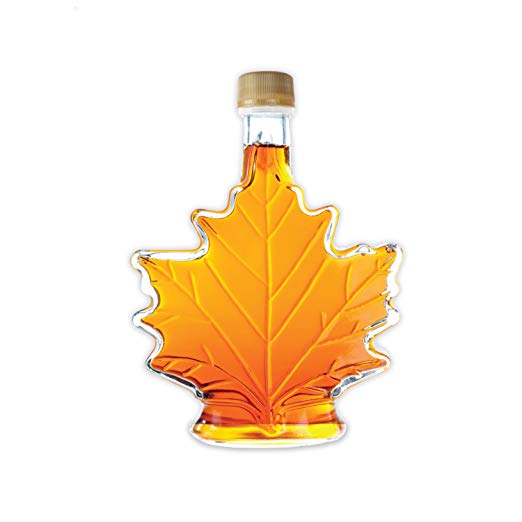
Tristan Foods Canadian Maple Syrup is a light and particularly sweet maple syrup that’s likely to be well-received by just about anyone.
The primary downsides are that the bottles contain only eight ounces of maple syrup, and the lightness of the syrup means you’re losing some of the complexity and richness that gives maple syrup its distinctive benefits.
9. ChocZero Maple Syrup
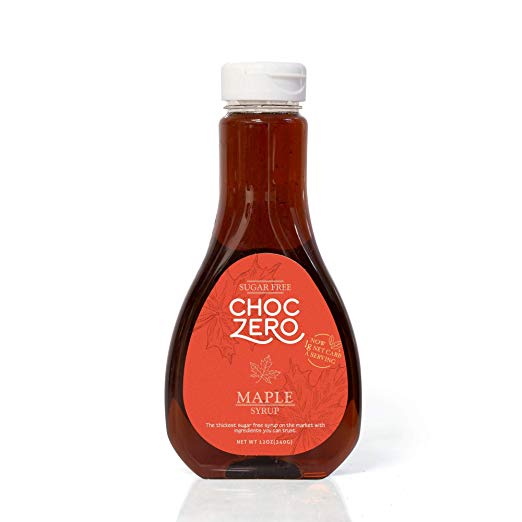
If you are on a low-carb or low sugar diet and miss maple syrup, ChocZero has a solution for you. This maple syrup has zero grams of sugar per serving.
How is this accomplished? ChocZero uses a combination of natural maple flavoring, monk fruit extract, caramel color, and liquid vegetable fiber to create a thick, sweet, syrup that’s sugar-free.
Obviously, it doesn’t have nearly the depth of flavor as real maple syrup, and the large amounts of fiber per serving could upset your stomach if you consume a lot of it. Despite these drawbacks, it’s the best option on the market for a sugar-free maple syrup replacement.
10. Highland Sugarworks Pure Maple Syrup

Highland Sugarworks Pure Maple Syrup is a darker and robust maple syrup that’s made from maple trees in Vermont.
While it is not organically certified like many of its competitors, it’s still a decent choice for a larger bottle of a dark maple syrup.
Category winners
Best maple syrup overall: Runamok Maple Syrup
Harvested from the best maple tree region in the world, Runamok is a versatile, top-quality maple syrup for any occasion, making it our top overall choice.
Best Vermont maple syrup: Runamok Maple Syrup
The northern climate and dense maple forests of Vermont make it the perfect place to harvest maple syrup, and among the many great options from Vermont, Runamok is our favorite. The smooth taste and light-bodied flavor will help it go over well with just about anything.
Best Canadian maple syrup: Escuminac Maple Syrup
When it comes to maple syrup production, two places are synonymous with top quality: Vermont and Canada. Escuminac is our pick for the best maple syrup north of the border, thanks to its light flavoring and smooth taste.
Best bulk-sized maple syrup: Hidden Springs Maple Syrup
For family dinners and big gatherings, Hidden Springs should be your go-to. This 32 ounce organically-certified maple syrup makes no sacrifices of quality for the sake of quantity.
Best maple syrup for pancakes: Runamok Maple Syrup
Should it be any surprise that our top overall pick is our favorite for pancakes? Runamok’s Vermont-harvested maple syrup is rich, smooth, and light-bodied, making it the perfect match for homemade pancakes.
Best low calorie maple syrup: ChocZero’s Maple Syrup
The distinctive taste of maple syrup makes it hard to replace in a low calorie, low carb, or keto diet, but ChocZero has done a pretty good job. Using liquid vegetable fiber, monk fruit, caramel color, and natural maple flavoring, this is as good as it gets without using the real thing.
Who should buy maple syrup?
Maple syrup is great for individuals of all ages who want to add a touch of sweetness to their food without a ton of processed sugar.
Maple syrup is also great for individuals who are on a paleo diet and need an all-natural form of sweetener that isn’t cane sugar. Maple syrup is considered safe for all individuals, including pregnant women and children. However, not all maple syrup is 100% natural, so it’s important to consider this before consuming any product.
How we ranked
There are 2 forms of maple syrup: natural and non-natural. Natural maple syrup is minimally processed, whereas conventional pancake syrup comes with a ton of sugar and unhealthy chemicals, including high-fructose corn syrup. Any product that was not pure maple syrup, like Highland Sugarworks, was axed from our list for health reasons. We did not want products that were essentially overly processed dessert to end up in our food.
Bottling was also an important aspect to consider when ranking maple syrup. Glass bottles are preferred if you plan to store your syrup for two years or more, while plastic jugs will keep syrup fresh in the refrigerator for up to four months. To extend the freshness and shelf life, we preferred products that came in glass bottles like Tristan Foods and Escuminac.
We also considered the grade of maple syrup when formulating our rankings. Originally, maple syrup was once subdivided into Grade A, and Grade B. Grade A was the lighter option of maple syrup and was comparable to the taste and consistency of artificial maple syrup. Grade B was significantly darker than Grade B and offered a stronger taste and thicker consistency.
As of recently, the regulations for the grading of maple syrup have changed, and Grade B syrup is no longer a classification available. Maple syrup is now subdivided into four Grade A categories (in order of darkness): Golden color, delicate taste; Amber color, a rich taste; Dark color, robust taste; Very dark color, strong taste. For our rankings, neither grade had an advantage over the other as they all offer great taste and benefits.
Benefits
Maple syrup is a natural sweetener made from the sap of maple trees, and may be somewhat better for your health than regular sugar. Even though it sounds like an improvement over white sugar, maple syrup has many of the same drawbacks and only a few slightly redeeming attributes, including some minerals and antioxidants you’d do better to get from real, nutritious food instead of a sweetener.
Maple syrup is less processed than table sugar. The process for making maple syrup is another plus over white sugar, since there are no chemicals involved. The circulating fluids of maple trees (sap) are siphoned off by tapping into tree veins and inserting tubes to carry out the goods.
While buckets may still be used to collect the liquid in smaller operations, modern commercial outfits usually run lines to a central reservoir (1).
This sweet liquid is boiled down to thick syrup and impurities are filtered out. Once the finished product is free of solids, it’s bottled and distributed.
Maple syrup has been around for centuries; Native Americans in the Northeast used it way back when, and today more than three-quarters of the world’s supply of maple syrup comes from Canada (2).
In North America, maple syrup comes in two grades. Grade A syrup is broken down into three categories by color: light amber, medium amber and dark amber.
These are usually more expensive, and purchased for direct consumption, like pouring over waffles or pancakes.
The Grade B syrup is very dark, has a stronger maple flavor, and is harvested later in the season, when the sap is more concentrated. It’s often used for baking or other recipes.
The distinct flavor makes maple syrup a popular choice. With adjustments for extra liquid, it can be used to replace sugar in recipes, and has inspired many specialty desserts and beverages because there’s no other sweetener that tastes quite like it.
Not all maple syrup on the market is 100% pure maple syrup. Many syrups are labeled with carefully worded reference to “real maple flavor.”
These may contain various amounts of actual maple syrup or maple sugar, from a dollop to a little more, while delivering most of the sweetness through high fructose corn syrup or other inferior sources.
The truth is, even pure maple syrup is just another form of sugar, and most of us eat far too much sugar as it is.
A full two-thirds of the sweetness in maple syrup comes from sucrose, which is the same as table sugar.
A hundred grams of maple syrup translates to 67 grams of sucrose; it’s still a high glycemic index food at 54, compared with sugar at 65, although it doesn’t jack up blood sugar quite as quickly as table sugar.
In recipes, maple syrup offers about the same amount of sweetening cup for cup as sugar, which would cut total sugar by about a third and add some minerals and antioxidants .
Maple syrup is especially rich in manganese, providing 159% of the RDA for this essential mineral. Manganese is important for bone health, and has been used to treat anemia and premenstrual syndrome (PMS). (3)
Zinc is also found in maple syrup at respectable amounts; 100 grams contains 26% of the RDA. It provides less than 10% of RDAs for other vital minerals, including iron, potassium and calcium. (4)
The antioxidants in maple syrup offer another slight benefit. Antioxidants play an important role in suppressing free radicals, those unstable electrons that bounce around in our systems, creating oxidative damage, accelerating the aging process, and likely upping the risk for developing certain diseases.
Maple syrup contains several different antioxidants. One study found 24 different antioxidants present in maple syrup, giving it strong anti-inflammatory abilities (5). The darker maple syrups are a richer source of antioxidants than the lighter ones, so definitely opt for a darker type of maple syrup if you want to take advantage of its antioxidant abilities (6).
But don’t expect to add any appreciable amount of these helpful substances by going heavy on the maple syrup.
Researchers who studied the question estimated if you replaced every bit of sugar you usually eat with maple syrup, the extra antioxidants you’d get could be matched by a handful of nuts or a half cup of berries (7).
A few other potentially beneficial substances in maple syrup have been isolated in lab studies conducted by Canadian growing companies, including one named quebecol for the Canadian province producing large quantities of maple syrup.
Active compounds found in maple syrup show potential for slowing the growth of cancerous tumors, as well as inhibiting the breakdown of carbohydrates in the digestive tract (8), but this doesn’t mean eating a lot of maple syrup is going to make you healthier.
Side effects
Minerals and antioxidants aside, maple syrup is another form of sugar, and eating sugar does not contribute to good health. In fact, sugar may be the most detrimental dietary component of all.
Eating excessive amounts of sugar, whether it comes from maple syrup, raw agave nectar, organic cane sugar, or any other kind of sugar, is a fast and efficient way to hurt yourself.
What’s considered excessive? Most American men and teenagers consume more than 300 calories daily from sugars alone, with women typically eating around 200.
The American Heart Association (AHA) recommends about half that amount as a maximum. (9)
The World Health Organization (WHO) issued a statement in 2015 recommending only 10% of energy intake should come from free sugars, adding that considerable health benefits could be realized by slashing that percentage in half (to about 6 teaspoons daily) (10).
Free sugars refer to added sugars like you’d find in soft drinks, processed foods, table sugar, fruit juices, jam and jelly, honey, and of course, maple syrup.
Including plenty of sugar in your diet can lead to serious health disorders like heart disease, obesity and type 2 diabetes. (11, 12, 13)
If you’re going to eat sweetened foods anyway, using maple syrup instead of sugar will cut your total intake by about a third.
But for those who are packing around extra pounds or need to improve metabolic health, including blood sugar levels and insulin sensitivity, choosing maple syrup as a sweetener won’t make an appreciable difference.
FAQ
When does maple syrup expire? Unopened containers of maple syrup do not typically go bad, though environmental conditions, like temperature and humidity, may affect their longevity. Once a bottle of maple syrup has been opened, it should be refrigerated to extend its shelf life. In general, maple syrup will last about a year when refrigerated.
How can you tell if maple syrup has gone bad? The most common sign that maple syrup has gone bad or is in the process of expiring is the presence of mold in the bottle. The mold usually develops on the top surface of the syrup and looks like light-colored white fungus or spores.
If maple syrup has a weird flavor, has it gone bad? While flavor inconsistency can be a sign of maple syrup going bad, it also may be a symptom of an actual defect of the syrup when the sap was tapped from the tree originally. When a tree is tapped at bud break, it often produces sap with a buddy flavor that is often described as tasting “off” to those consuming it (14).
How many maple trees does it take to make a gallon of syrup? Maple syrup does not come directly from maple trees, as it is a byproduct of the sap produced by the tree. It takes approximately 40 gallons of sap to create 1 gallon of syrup. On average, a maple tree can produce more than 10 gallons of sap within one season. Given that information, it’ll take about 4 trees to produce 1 gallon of maple syrup.
What can maple syrup be used for? The most common way to use maple syrup is as a condiment for food. Maple syrup is most often used to top off a plate of pancakes or waffles to add some sweeteness. It is also used as an ingredient in some dishes, such as glazed ham and baked beans.
Maple syrup is also being recognized for its potential use as a skincare product to reduce wrinkles and smooth the skin.
Is maple syrup healthier than honey? In the nutritional battle of maple syrup and honey, maple syrup contains significantly more important nutrients than honey per ¼ cup serving. Maple syrup boasts the following percentage of daily values: 37% riboflavin, 95% manganese, 5% calcium, 6% zinc, and 5% potassium. Per serving, maple syrup contains about 216 calories, as compared to honey’s 261 calories. If given a choice between honey and maple syrup, the recommended choice would be maple syrup, given its impressive nutritional value.
Is maple syrup unhealthy? While maple syrup is rich in minerals and antioxidants, it can still be unhealthy, especially if it’s not natural syrup, which can contain up to 50g of sugar per serving. Darker maple syrup is healthier than lighter maple syrup, as it includes a greater amount of minerals and antioxidants. In terms of sugar content, there is not a notable difference between lighter and darker syrups, though overall, darker syrups are the better health option in terms of nutritional value (15).
Can vegans eat maple syrup? Yes, vegans can eat maple syrup. Since maple syrup comes from sap, which is a direct product of maple trees, maple syrup is 100% vegan-friendly.
What is the difference between pancake syrup and maple syrup? Maple syrup and pancake syrup vary greatly when it comes to recipe ingredients. Maple syrup is typically a pure syrup produced directly from maple sap without the addition of extra ingredients. The process of creating maple syrup is relatively simple and does not require anything more than boiling the sap. Conversely, pancake syrup is the more common type of syrup found in grocery and convenience stores. These are the name brand syrups that are made of corn syrup or high-fructose corn syrup. These syrups are artificially made and sweetened and are not natural in any sense. Pancake syrup should be considered a dessert and is not a healthy choice by any means.
How is maple syrup made? Maple syrup is created from the sap that comes from maple trees. The recommended tree size for tapping maple trees is about a 12-inch diameter, with larger trees producing a greater amount of sap per season. Tapping the tree requires “spiles,” which are tube-like metal fixtures that are inserted into the bark of the tree to allow the sap to exit. A bucket or other collection device is attached to the spile to collect the sap as it leaves the maple tree. Once a large amount of sap has been collected, and the tree has been completely tapped, the sap is boiled to about 219 degrees. At this point, the sap has officially become syrup. The syrup should then be cooled and stored for future use.
Is maple syrup good for weight loss? Maple syrup is not great for those looking to lose weight. Maple syrup is high in calories and sugar, and it would not be recommended that a person dieting consume maple syrup intentionally to lose weight. Though years ago, the “Maple Syrup Diet” became a fad targeting those seeking weight loss, it was an extremely unhealthy dieting method and is not recommended by any medical professionals.
Can diabetics eat maple syrup? While the sugar included in maple syrup is natural, the sugar levels per serving are not ideal for a diabetic. With a glycemic index of about 54, it would be accurate to consider this a relatively high sugar count for a diabetic, making maple syrup a food that should not be eaten regularly by diabetics.
Should you refrigerate maple syrup? Maple syrup does not have to be refrigerated when it is unopened and can be stored in a pantry. However, once it has been opened and used, maple syrup should be refrigerated to extend its shelf-life and prevent the formation of mold on the syrup’s surface.
What benefits does maple syrup have? Given the nutrients naturally found in maple syrup products, there are some indirect benefits of consuming maple syrup. Because maple syrup includes naturally-occurring antioxidants, this ultimately may reduce the risk of developing cancer if consumed consistently and long-term. Some research supports the idea that products like maple syrup may prevent or fight inflammatory diseases. Maple syrup contains phenolic, which is shown too slow the aging process and help fight diseases like Alzheimer’s Disease.
Is maple syrup a laxative? Though it would not be recommended to use maple syrup in place of natural or artificial laxatives, maple syrup and sap can produce laxative-like benefits for consumers. When maple syrup is pure, natural sugars can boost gastrointestinal functioning and reduce constipation.
What grade of maple syrup is best? Originally, maple syrup was once subdivided into Grade A and Grade B. Today, the regulations for the grading of maple syrup have changed, and Grade B syrup is no longer a classification available. Maple syrup is now subdivided into four Grade A categories, based on the color (15).
Is maple syrup less processed than table sugar? Yes, maple syrup is less processed than table sugar. The sap of the maple trees is siphoned off by tapping into tree veins and collected. The sweet liquid is boiled down to thick syrup, and impurities are filtered out.
How long has maple syrup been around? Maple syrup has been around for centuries dating back to Native Americans in the Northeast.
How many grades does maple syrup come in? In North America, maple syrup comes in two grades.
What is grade A maple syrup? Grade A syrup tends to be lighter in flavor and is broken down into three categories based on color: light amber, medium amber, and dark amber. Grade A syrups are almost always more expensive, and often sold as a syrup for pancakes and waffles.
What is grade B maple syrup? The Grade B syrup is often used for baking or other recipes due to its strong maple flavor. It’s also harvested later in the season when the sap is more concentrated. With adjustments in liquid consistency, it can be used to replace sugar in a variety of recipes and has inspired many specialty desserts and beverages due to its unique flavor profile
Are all maple syrups pure? Unfortunately, not all maple syrup on the market is 100% pure maple syrup. If the label says “real maple flavor,” it is often a low-quality product containing a small amount of maple syrup while delivering most of the sweetness through high fructose corn syrup or other inferior sources.
How much sugar does maple syrup contain? Maple syrup contains a lot of sugar, with 100g containing 67g of sucrose. However, in baking, it actually helps to reduce the amount of sugar. Maple syrup offers about the same amount of sweetening cup for cup as sugar, which would cut total sugar by about a third and add some minerals and antioxidants.
Does maple syrup contain antioxidants? Maple syrup contains up to 24 different antioxidants giving it strong anti-inflammatory abilities. Dark maple syrups provide more antioxidants than the light-colored ones.
Does maple syrup provide nutrients? Maple syrup is especially rich in manganese, which is important for bone health, providing 159% of the RDA for this essential mineral. Maple syrup also contains zinc, iron, potassium, and calcium.
Is sugar bad for you? Sugar, like most things, is bad for you when consumed in excess, even if comes from healthy sources like maple syrup.
How many calories does natural maple syrup contain? 100g of pure maple syrup contains 260 calories, 0.1g of fat, 67g of carbs and zero protein. It also contains 212mg of potassium, 12mg of sodium, 68g of sugar, up to 10% of your daily calcium and up to 5% of your daily magnesium. The percent daily values are based on a 2000 calorie daily diet, so the daily recommendation numbers may fluctuate different depending on your specific caloric requirements.
Related Articles
Recap
Maple syrup is a slightly better way to add sweetness to your food than table sugar. It adds some manganese to your diet, as well as a wide range of antioxidants. In an absolute sense, the antioxidant power isn’t that strong compared to something like a green superfood drink, but it’s still better than nothing. Even with these benefits, maple syrup is still a sugary sweetener, so you should use it sparingly. The unique flavor of maple syrup makes it an excellent choice for the occasional treat, but the minimal benefits of this natural sweetener don’t justify heavy everyday use.
For BodyNutrition’s #1 maple syrup recommendation, click here.